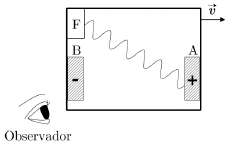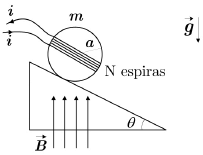Foram encontradas 70 questões.
Os pontos !$ B=(1,1+6 \sqrt2) !$ e !$ C=(1+6 \sqrt2,1) !$ são vértices do triângulo isósceles ABC de base BC, contido no primeiro quadrante. Se o raio da circunferência inscrita no triângulo mede 3, então as coordenadas do vértice A são
Provas
Questão presente nas seguintes provas
O som produzido pelo alto-falante !$ F !$ (fonte) ilustrado na figura tem frequência de 10 kHz e chega a um microfone !$ M !$ através de dois caminhos diferentes. As ondas sonoras viajam simultaneamente pelo tubo esquerdo FXM, de comprimento fixo, e pelo tubo direito FYM, cujo comprimento pode ser alterado movendo-se a seção deslizante (tal qual um trombone). As ondas sonoras que viajam pelos dois caminhos interferem-se em !$ M !$. Quando a seção deslizante do caminho FYM é puxada para fora por 0,025 m, a intensidade sonora detectada pelo microfone para de um máximo para um mínimo. Assinale o módulo da velocidade do som no interior do tubo.

Provas
Questão presente nas seguintes provas
A questão refere-se ao texto destacado:
“Of course they’re fake videos, everyone can see they're not real. All the same, they really did say those things, didn't they?” These are the words of Vivienne Rook, the fictional politician played by Emma Thompson in the brilliant dystopian BBC TV drama Years and Years. The episode in question, set in 2027, tackles the subject of “deepfakes” – videos in which a living person's face and voice are digitally manipulated to say anything the programmer wants.
Rook perfectly sums up the problem with these videos – even if you know they are fake, they leave a lingering impression. And her words are all the more compelling because deepfakes are real and among us already. Last year, several deepfake porn videos emerged online, appearing to show celebrities such as Emma Watson, Gal Gadot and Taylor Swift in explicit situations.
[…]
In some cases, the deepfakes are almost indistinguishable from the real thing – which is particularly worrying for politicians and other people in the public eye. Videos that may initially have been created for laughs could easily be misinterpreted by viewers. Earlier this year, for example, a digitally altered video appeared to show Nancy Pelosi, the speaker of the US House of Representatives, slurring drunkenly through a speech. The video was widely shared on Facebook and YouTube, before being tweeted by President Donald Trump with the caption: “PELOSI STAMMERS THROUGH NEWS CONFERENCE”. The video was debunked, but not before it had been viewed millions of times. Trump has still not deleted the tweet, which has been retweeted over 30,000 times.
The current approach of social media companies is to filter out and reduce the distribution of deepfake videos, rather than outright removing them – unless they are pornographic. This can result in victims suffering severe reputational damage, not to mention ongoing humiliation and ridicule from viewers. “Deepfakes are one of the most alarming trends I have witnessed as a Congresswoman to date,” said US Congresswoman Yvette Clarke in a recent article for Quartz. “If the American public can be made to believe and trust altered videos of presidential candidates, our democracy is in grave danger. We need to work together to stop deepfakes from becoming the defining feature of the 2020 elections.”
Of course, it’s not just democracy that is at risk, but also the economy, the legal system and even individuals themselves. Clarke warns that, if deepfake technology continues to evolve without a check, video evidence could lose its credibility during trials. It is not hard to imagine it being used by disgruntled ex-lovers, employees and random people on the internet to exact revenge and ruin people’s reputations. The software for creating these videos is already widely available.
Fonte: Curtis, Sophie. https://www.mirror.co.uk/tech/deepfake-videos-creepy-new-internet-18289900. Adaptado. Acessado em Agosto/2019.
De acordo com o texto, é correto afirmar que
Provas
Questão presente nas seguintes provas
Leia o trecho destacado para responder a questão.
... O vereador fez esta reflexão: — Nada tenho que ver com a ciência; mas se tantos homens em quem supomos juízo são reclusos por dementes, quem nos afirma que o alienado não é alienista? [Contos, p. 299].
Acerca do sentido da narrativa, o trecho destacado permite afirmar que
Provas
Questão presente nas seguintes provas
A figura ilustra um experimento numa plataforma que, no referencial de um observador externo, se move com velocidade !$ \vec{v} !$ constante de módulo comparável ao da velocidade da luz. No instante !$ t_0 !$, a fonte !$ F !$ emite um pulso de luz de comprimento de onda !$ λ !$ que incide sobre a placa metálica !$ A !$, sendo por ela absorvido e, em consequência, emitindo elétrons, que são desacelerados pela diferença de potencial !$ A_{AB} !$. Considerando que os elétrons atingem a placa !$ B !$ a partir do instante !$ t !$, assinale a alternativa que referencia apenas variações independentes que diminuem o intervalo de tempo !$ \Delta t=t-t_0 !$ medido pelo observador.

Provas
Questão presente nas seguintes provas
Ao redor de um cilindro de massa !$ m !$, raio !$ a !$ e comprimento !$ b !$, são enrolados simétrica e longitudinalmente !$ N !$ espiras. Estas são dispostas paralelamente a um plano inclinado onde se encontra um cilindro, que não desliza devido ao atrito com a superfície do plano. Considerando a existência de um campo magnético uniforme e vertical !$ \vec{B} !$ na região, assinale a intensidade da corrente !$ i !$ que deve circular nas espiras para que o conjunto permaneça em repouso na posição indicada pela figura.

Provas
Questão presente nas seguintes provas
A questão refere-se ao texto destacado.
About seven years ago, three researchers at the University of Toronto built a system that could analyze thousands of photos and teach itself to recognize everyday objects, like dogs, cars and flowers. The system was so effective that Google bought the tiny start-up these researchers were only just getting off the ground. And soon, their system sparked a technological revolution. Suddenly, machines could “see” in a way that was not possible in the past.
This made it easier for a smartphone app to search your personal photos and find the images you were looking for. It accelerated the progress of driverless cars and other robotics. And it improved the accuracy of facial recognition services, for social networks like Facebook and for the country’s law enforcement agencies. But soon, researchers noticed that these facial recognition services were less accurate when used with women and people of color. Activists raised concerns over how companies were collecting the huge amounts of data needed to train these kinds of systems. Others worried these systems would eventually lead to mass surveillance or autonomous weapons.
Fonte: Matz, Cade. Seeking Ground Rules for A. I. www.nytimes.com, 01/03/2019. Adaptado. Acessado em Agosto/2019.)
Analise as afirmações de I a IV em destaque.
I. Ativistas manifestaram preocupação em relação à forma como as empresas estavam coletando enormes quantidades de dados para treinar sistemas de reconhecimento.
II. A Universidade de Toronto construiu um sistema ético de Inteligência Artificial para reconhecimento de imagens.
III. Uma das preocupações de ativistas era a possibilidade de tais sistemas conduzirem a vigilância em massa ou armamento autônomo.
IV. Empresas privadas de tecnologia, como Google, e redes digitais, como Facebook, junto com algumas agências governamentais, chegaram a um consenso quanto a uma ética da Inteligência Artificial.
V. Algumas leis foram desenvolvidas por alguns grupos específicos de pessoas para decidir sobre o futuro da Inteligência Artificial.
De acordo com o texto, estão corretas apenas:
Provas
Questão presente nas seguintes provas
Considere o circuito da figura no qual há uma chave elétrica, um reostato linear de comprimento total de 20 cm, uma fonte de tensão !$ V=1,5 \, V !$ e um capacitor de capacitância !$ C=10 \, μ F !$ conectado a um ponto intermediário do reostato, de modo a manter contato elétrico e permitir seu carregamento. A resistência !$ R\ !$ entre uma das extremidades do reostato e o ponto de contato elétrico, a uma distância !$ x !$, varia segundo o gráfico abaixo.

Provas
Questão presente nas seguintes provas
A questão refere-se ao teto destacado a seguir:
Experts warn that “the substitution of machinery for human labour” may “render the population redundant”. They worry that “the discovery of this mighty power” has come “before we knew how to employ it rightly”. Such fears are expressed today by those who worry that advances in artificial intelligence (AI) could destroy millions of jobs and pose a “Terminator”-style threat to humanity. But these are in fact the words of commentators discussing mechanisation and steam power two centuries ago. Back then the controversy over the dangers posed by machines was known as the “machinery question”. Now a very similar debate is under way.
After many false dawns, AI has made extraordinary progress in the past few years, thanks to a versatile technique called “deep learning”. Given enough data, large (or “deep”) neural networks, modelled on the brain’s architecture, can be trained to do all kinds of things. They power Google’ssearch engine, Facebook’s automatic photo tagging, Apple’s voice assistant, Amazon’s shopping recommendations and Tesla’s self-driving cars. But this rapid progress has also led to concerns about safety and job losses. Stephen Hawking, Elon Musk and others wonder whether AI could get out of control, precipitating a sci-fi conflict between people and machines. Others worry that AI will cause widespread unemployment, by automating cognitive tasks that could previously be done only by people. After 200 years, the machinery question is back. It needs to be answered.
Fonte: https://www.economist.com/leaders/2016/06/25/march-of-the-machines. Adaptado. Acesso em agosto de 2019.
A palavra sublinhada nos trechos retirados do texto pode ser substituída, sem alteração de significado, pela palavra ou expressão da segunda coluna, exceto em:
Provas
Questão presente nas seguintes provas
O tiocianato de cobre é um condutor sólido do tipo p com aplicações optoeletrônicas e fotovoltaicas, como células solares. O CuSCN reage com o iodato de potássio na presença de ácido clorídrico para formar sulfato de cobre, ácido cianídrico, cloreto de potássio e monocloreto de iodo. O valor da soma dos menores coeficientes estequiométricos inteiros da reação líquida é igual a
Provas
Questão presente nas seguintes provas
Cadernos
Caderno Container